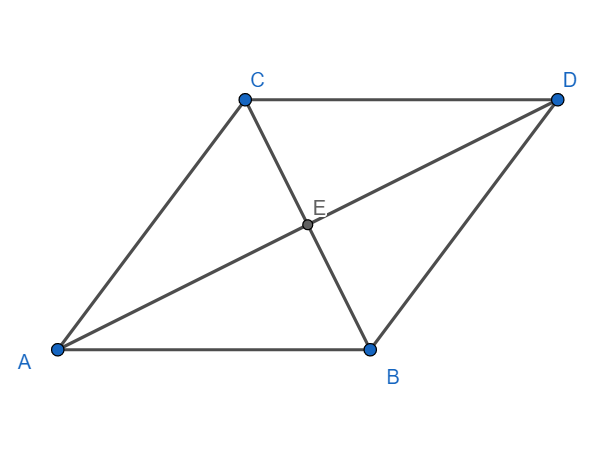
The diagonals of a rhombus are 12cm and 7.5cm. Find its area.
Answer
507.9k+ views
Hint: Use the fact that the diagonals of a rhombus bisect each other at right angles. Using the property that the area of a triangle with base b and height h is given by $\dfrac{1}{2}bh$. Hence find the area of each of the triangles in which the rhombus is divided by the diagonals. Hence find the area of the rhombus. Alternatively, use the fact that the area of the rhombus with diagonals ${{d}_{1}}$ and ${{d}_{2}}$ is given by $\dfrac{1}{2}{{d}_{1}}{{d}_{2}}$. Hence determine the area of the rhombus.
Complete step-by-step answer:

Consider the rhombus ABCD, with AD = 12cm and BC = 7.5cm.
Since the diagonals of a rhombus bisect each other, we have
$CE=\dfrac{7.5}{2}=3.75=BE$ and $AE=\dfrac{12}{2}=6=DE$.
Now, we have
In the triangle DEC $DE\bot CE$(diagonals of a rhombus are perpendicular to each other).
Hence, we have
$ar\left( \Delta DEC \right)=\dfrac{1}{2}\times DE\times CE=\dfrac{1}{2}\times 6\times 3.75=11.25$
Similarly, we have
$ar\left( \Delta BEC \right)=ar\left( \Delta AEB \right)=ar\left( \Delta AEC \right)=11.25$
The area of the rhombus ABCD is the sum of the area of the triangle AEB, AEC, DEC and DEB
Hence, we have
$ar\left( ABCD \right)=11.25+11.25+11.25+11.25=4\times 11.25=45$
Hence the area of the rhombus ABCD = 45 square centimetres.
Note: Alternatively, we know that the area of a rhombus with diagonals ${{d}_{1}}$ and ${{d}_{2}}$ is given by $\dfrac{1}{2}{{d}_{1}}{{d}_{2}}$
Here, we have
${{d}_{1}}=12cm$ and ${{d}_{2}}=7.5cm$
Hence, the area of rhombus
$=\dfrac{1}{2}\left( 12 \right)\times \left( 7.5 \right)=45$ square centimetres, which is the same as obtained above.
Complete step-by-step answer:

Consider the rhombus ABCD, with AD = 12cm and BC = 7.5cm.
Since the diagonals of a rhombus bisect each other, we have
$CE=\dfrac{7.5}{2}=3.75=BE$ and $AE=\dfrac{12}{2}=6=DE$.
Now, we have
In the triangle DEC $DE\bot CE$(diagonals of a rhombus are perpendicular to each other).
Hence, we have
$ar\left( \Delta DEC \right)=\dfrac{1}{2}\times DE\times CE=\dfrac{1}{2}\times 6\times 3.75=11.25$
Similarly, we have
$ar\left( \Delta BEC \right)=ar\left( \Delta AEB \right)=ar\left( \Delta AEC \right)=11.25$
The area of the rhombus ABCD is the sum of the area of the triangle AEB, AEC, DEC and DEB
Hence, we have
$ar\left( ABCD \right)=11.25+11.25+11.25+11.25=4\times 11.25=45$
Hence the area of the rhombus ABCD = 45 square centimetres.
Note: Alternatively, we know that the area of a rhombus with diagonals ${{d}_{1}}$ and ${{d}_{2}}$ is given by $\dfrac{1}{2}{{d}_{1}}{{d}_{2}}$
Here, we have
${{d}_{1}}=12cm$ and ${{d}_{2}}=7.5cm$
Hence, the area of rhombus
$=\dfrac{1}{2}\left( 12 \right)\times \left( 7.5 \right)=45$ square centimetres, which is the same as obtained above.
Recently Updated Pages
The correct geometry and hybridization for XeF4 are class 11 chemistry CBSE

Water softening by Clarks process uses ACalcium bicarbonate class 11 chemistry CBSE

With reference to graphite and diamond which of the class 11 chemistry CBSE

A certain household has consumed 250 units of energy class 11 physics CBSE

The lightest metal known is A beryllium B lithium C class 11 chemistry CBSE

What is the formula mass of the iodine molecule class 11 chemistry CBSE

Trending doubts
State the laws of reflection of light

One Metric ton is equal to kg A 10000 B 1000 C 100 class 11 physics CBSE

Difference Between Prokaryotic Cells and Eukaryotic Cells

How do I convert ms to kmh Give an example class 11 physics CBSE

Give an example of a solid solution in which the solute class 11 chemistry CBSE

Describe the effects of the Second World War class 11 social science CBSE




